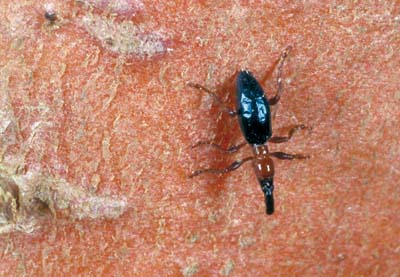
Adult sweetpotato weevil, Cylas formicarius elegantulus.
(Photographer: L.J. Buss, University of Florida)
The sweetpotato weevil is the most serious pest of sweet potato around the world. It causes damage in the field, in storage, and is of quarantine significance. The larva creates winding tunnels packed with fecal material as it feeds and grows. This species was formerly listed in the family Curculionidae.
The adult is striking in form and color. The body, legs, and head are long and thin, giving it an ant-like appearance. The head is black, the antennae, thorax and legs orange to reddish brown, and the abdomen and elytra are metallic blue. The snout is slightly curved and about as long as the thorax; the antennae are attached at about the mid point on the snout. The adult measures 5.5 to 8.0 mm in length and can live over 200 days. The adult is quick to feign death if disturbed. Adults can fly, but seem to do so rarely and in short, low flights.
A complete life cycle requires one to two months, with 35 to 40 days being common during the summer months. The female deposits a single egg at a time. Females apparently produce two to four eggs per day, or 75 to 90 eggs during their life span of about 30 days. The larva is legless and white in color. The generations are indistinct, ranging from five to eight per year.
Images
To save the Web-optimized images shown below to your hard drive:
|
Click to access Display and Print quality images. |
|
Click to access Display and Print quality images. |
|
Click to access Display and Print quality images. |